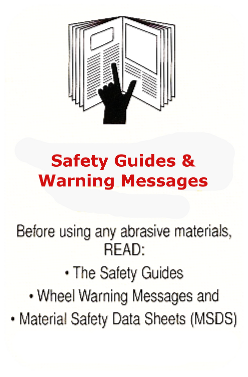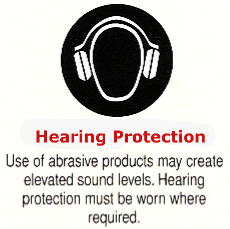ZEC® Disc Safety Precautions
To Order Call: (330) 293-1447
Personal Protective Equipment (PPE)


Eye/Face Protection
Avoid eye contact. To minimize the risk of injury to face and eyes, always wear eye and face protection when working at sanding or grinding operations or when near such operations. The following eye protection(s) are recommended: Safety Glasses with side shields.
Respiratory Protection
Avoid breathing of dust created by sanding, grinding or machining. Consider material being abraded when determining the appropriate respiratory protection. Select and use appropriate respirators to prevent inhalation overexposure. Select one of the following NIOSH approved respirators based on airborne concentration of contaminants and in accordance with OSHA regulations: Half facepiece or fullface air-purifying respirator with N95 particulate filters. Consult with your respirator manufacturer for selection of appropriate types of respirators.
Skin Protection
Avoid skin contact. Wear appropriate gloves to minimize risk of injury to skin from contact with dust or physical abrasion from grinding or sanding.
Prevention of Swallowing
Not an expected route of exposure. Wash hands after handling and before eating.
Potential Health Effects


Eye Contact
Mechanical eye irritation: Signs/symptoms may include pain, redness, tearing and corneal abrasion. Dust created by grinding, sanding, or machining may cause eye irritation. Signs/symptoms may include redness, swelling, pain, tearing, and blurred or hazy vision.
Skin Contact
Mechanical Skin irritation: Signs/symptoms may include abrasion, redness, pain, and itching.
Inhalation
Dust from grinding, sanding or machining may cause irritation of the respiratory system. Signs/symptoms may include cough, sneezing, nasal discharge, headache, hoarseness, and nose and throat pain. Prolonged or repeated exposure may cause:
Pneumoconiosis: Sign/symptoms may include persistent cough, breathlessness, chest pain, increased amounts of sputum, and changes in lung function tests.
First Aid Procedures

The following first aid recommendations are based on an assumption that appropriate personal and industrial hygiene practices are followed.
Eye Contact
Flush eyes with large amounts of water. If signs/symptoms persist, get medical attention.
Skin Contact
Wash affected area with soap and water. If signs/symptoms develop, get medical attention.
Inhalation
Remove person to fresh air. If signs/symptoms develop, get medical attention.
